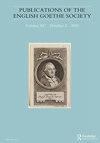雪莱浮士德翻译的语境
IF 0.1
3区 文学
0 LITERATURE, GERMAN, DUTCH, SCANDINAVIAN
引用次数: 0
摘要
珀西·比希·雪莱对歌德的《浮士德》的迷恋贯穿了他写作生涯的大部分时间,从1815年这部戏剧开场开始,他逐行翻译了近千行,并在1822年7月他英年早逝前不久完成了对《Prolog im Himmel》和《Walpurgisnacht》的诗意演绎。这篇文章提供了一个详细的检查两个浮士德译本和他们产生的背景。1815年的翻译是在当代语言学习材料的背景下阅读的,而1822年的翻译是与歌德的世界文学概念有关的,它是一个跨越语言边界的文本遭遇网络。本文章由计算机程序翻译,如有差异,请以英文原文为准。
The Contexts of Percy Bysshe Shelley’s Faust Translations
ABSTRACT Percy Bysshe Shelley’s fascination with Goethe’s Faust spanned a large part of his writing career, starting with a line-by-line translation of nearly a thousand lines from the drama’s opening in 1815 and culminating in a poetic rendition of the ‘Prolog im Himmel’ and ‘Walpurgisnacht’ finished shortly before his untimely death in July 1822. This article offers a detailed examination of the two Faust translations and the contexts in which they were produced. The 1815 translation is read against the backdrop of contemporary language learning materials whereas the 1822 translation is brought into relation with Goethe’s conception of Weltliteratur as a web of textual encounters across linguistic boundaries.
求助全文
通过发布文献求助,成功后即可免费获取论文全文。
去求助
来源期刊

Publications of the English Goethe Society
LITERATURE, GERMAN, DUTCH, SCANDINAVIAN-
CiteScore
0.10
自引率
0.00%
发文量
15
 求助内容:
求助内容: 应助结果提醒方式:
应助结果提醒方式:


